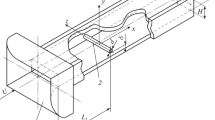Abstract
The structure of the flow in an inlet with three-dimensional compression and an adjoining channel of rectangular cross-section is experimentally investigated for the external flow parameters M∞ = 4 and Re ≈ 52 · 106 1/m. The phenomenon of vortex generation in the air-intake and its breakdown at the channel entry, where it encounters an elevated pressure gradient, is studied
Similar content being viewed by others
References
R. I. Kurziner, Jet Engines for High Supersonic Flight Velocities [in Russian], Mashinostroenie, Moscow (1989).
“Ground testing of the Aerojet rocket-ramjet engine ’stratojet’”, Aviation Week, 151, No. 1, 57 (1999).
H. Taguchi, M. Maita, N. Yatsuyanagi, and T. Yamanaka, “Airbreather/rocket combined propulsion system research for Japanese SSTO spaceplane,” AIAA Paper, No. 4811 (1999).
V. G. Gurylev, M. Yu. Korchinskaya, and A. F. Chevagin, “Flow structure and maximum static pressures at the entry and throat of plane air-intakes at high supersonic velocities,” Uch. Zap. TsAGI, 16, No. 1, 46 (1985).
A. F. Chevagin, V. A. Vinogradov, S. V. Evdokimov, and V. A. Stepanov, “Distinctive features of the internal characteristics of three-dimensional hypersonic air-intakes,” Tekhn. Vozd. Flota, No. 4–6, 33 (1992).
A. M. Kharitonov, A. V. Lokotko, A. V. Tchernyshyev, V. I. Kopchenov, K. E. Lomkov, and A. S. Rudakov, “Mixing processes of supersonic flows in a model duct of a rocket scramjet engine,” AIAA Paper, No. 0559 (2000).
V. A. Bashkin, I. V. Egorov, and D. V. Ivanov, “Mach number effect on the flowfield and the aerodynamic characteristics of an unadjustable hypersonic air-intake at Re = 106,” Uch. Zap. TsAGI, 33, No. 1–2, 15 (2002).
M. A. Goldfeld, A. V. Starov, and V. A. Vinogradov, “Experimental investigations of a three-dimensional air-intake of a rocket-scramjet engine module,” Teplofiz. Aeromekh., 7, 489 (2000).
V. V. Zatoloka, A. K. Ivanyushkin, and A. V. Nikolaev, “Interference of vortices with shocks in an air-intake. Vortex breakdown,” Uch. Zap. TsAGI, 6, No. 2, 134 (1975).
V. Ya. Borovoy, T. V. Kubyshina, A. S. Skuratov, and L. V. Yakovleva, “Vortex in a supersonic flow and its influence on blunt body flow and heat transfer,” Fluid Dynamics, 35, No. 5, 682 (2000).
M. K. Smart, I. M. Kalkhoran, and A. Betti, “Interaction of supersonicwing tip vortices with a normal shock, AIAA J., 34, 1855 (1996).
G. F. Glotov, “Interference of a vortex filament with shocks in a free flow and nonisobaric jets, ” Uch. Zap. TsAGI, 20, No. 5, 21 (1989).
E. Krause, “Shock induced vortex breakdown,” in: Proc. Xth Intern. Conf. Methods of Aerophysical Research. Part 2, Novosibirsk (2000), p. 109.
M. K. Smart and I. M. Kalkhoran, “Effect of shock strength on oblique shock wave —vortex interaction,” AIAA J., 33, 2137 (1995).
V. N. Zudov and E. A. Pimonov, “Interaction between a longitudinal vortex and an oblique shock, ” Zh. Prikl. Mekh. Tekhn. Fiz., 44, No. 4, 10 (2003).
L. F. F. Da Silva, V. Sabel’nikov, and B. Deshaies, “Stabilization of supersonic combustion by a free recirculating bubble: A numerical study,” AIAA J., 35, 1782 (1997).
A. N. Volkova and N. N. Novichkov, “Concepts of promising reusable air-based aeroassisted orbiters, ” TsAGI Review, No. 686 (1989).
M. S. Lapin, E. V. Malyutina, and Yu. Ya. Shilov, “Problems of development of aircraft with hypersonic cruise velocities,” TsAGI Technical Information, No. 9, 7 (1979).
A. I. Maksimov and A. A. Pavlov, “Development of the “laser knife” technique for visualizing flows in supersonic wind tunnels,” Uch. Zap. TsAGI, 17, No. 5, 39 (1986).
A. I. Maksimov, “A photorecording device,” Bull. Izobret., No. 25, 17 (1988).
G. V. Bazhenova, L. G. Gvozdeva, Yu. P. Lagutov, et al., Time-Dependent Interaction of Shock and Detonation Waves in Gases [in Russian], Nauka, Moscow (1986).
N. E. Kochin, I. A. Kibel’, and N. V. Roze, Theoretical Hydromechanics. Vol. 2 [in Russian], Fizmatgiz, Moscow (1963).
A. Nedungadi and M. J. Lewis, “Computational study of the flowfields associated with oblique shock/vortex interaction,” AIAA J., 34, 2545 (1996).
S. Leibovich, “Vortex stability and breakdown: survey and extension,” AIAA J., 22, 1192 (1984).
P. K. Chang, Separation of Flow. Vol. 2, Pergamon Press, Oxford (1970).
L. G. Loytsianskii, Mechanics of Liquids and Gases, Pergamon Press, Oxford (1966).
Additional information
__________
Translated from Izvestiya Rossiiskoi Academii Nauk, Mekhanika Zhidkosti i Gaza, No. 4, 2006, pp. 182–194.
Original Russian Text Copyright © 2006 by Lokotko and Kharitonov.
Rights and permissions
About this article
Cite this article
Lokotko, A.V., Kharitonov, A.M. On the possible formation of a vortex flow in a supersonic inlet with three-dimensional compression. Fluid Dyn 41, 649–660 (2006). https://doi.org/10.1007/s10697-006-0084-1
Received:
Issue Date:
DOI: https://doi.org/10.1007/s10697-006-0084-1



